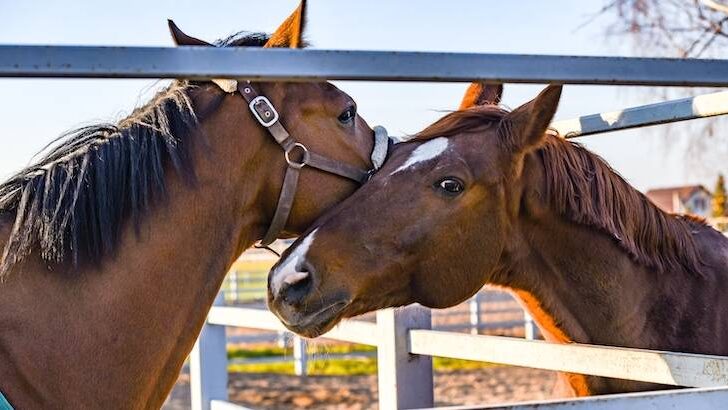Affiliate Disclaimer
As an Amazon Associate I earn from qualifying purchases. It helps me keep the website going. Thank you for your support.
Communication is necessary for survival in every species. Animals communicate using sound and nonverbal communication like gestures since they cannot use words. With this in mind, how do horses communicate?
The sounds horses use to communicate with their herd members, other horses, and different species include whinnies, neighs, nickers, and squeals. They can also communicate nonverbally using their body language and using their eyes, ears, tails, and legs to express emotion.
Horses are bright and animated animals. Follow along to learn more about the unique ways they share information with the world around them.
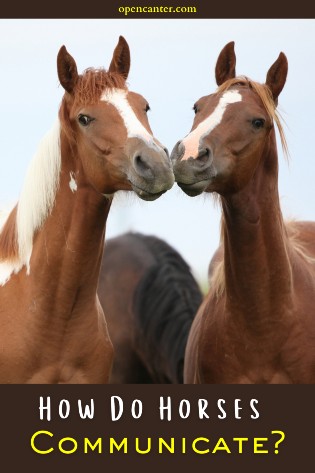
What Tools Do Horses Have to Communicate?
Horses express and communicate things with their world using their whole body. Let’s break down all of their tools of communication in this section.
Equine Vocalizations
The first tools horses use are the throat and the vocal cords to create vocalizations. Vocalizations are sounds used to communicate. They are the language of the horse.
The equine vocalizations are:
- Neigh/Whinny- the neigh or whinny is a high or low-pitched vocalization used to greet another horse or owner or tell herd members where they are. It is the longest of all equine sounds
- Nicker- the nicker is a low-pitched sound that resounds from the gut. It is used to communicate happiness or contentment and is heard at feeding time. Here are some other ways to tell if a horse is happy.
- Snort- a snort is a sound made when horses exhale quickly. Heard when a horse is cantering or doing hard exercise
- Squeal- a squeal is a high-pitched sound horse make with their mouth closed. Horses squeal when they do not like something, are signaling aggression, or are in fight or flight mode. When horses start squealing at each other, do your best to separate them
- Blow- a blow is a shorter version of the snort. Horses blow when curiously examining something or greeting a human or horse.
- Grunt or Groan- horses grunt as humans do. A grunt is most often a sign of pain and discomfort.
- Sigh- the sigh is equivalent to that of humans and consists of a slow inhale and exhale. Horses sigh when they are content, relaxed, or tired.

Horses are vocal creatures, but they also use body language and subtle cues to communicate.
How Horses Communicate with Non-Vocal Cues
Aside from sounds, horses use their eyes, ears, head, neck, legs, and tail to express themselves. This section will explore how horses use body language.
Eye Communication
Horses have acute eyesight and the way their eyes look will give information about their mood. When a horse is afraid or stressed, you will see the sclera, or the white part of its eye, more often than normal.
You will also notice a scared horse’s eyes are wide and hold tension. When a horse is calm, you will see the iris or colored part of the eye. The eye will be relaxed and show no signs of stress.
Ear Communication
Based on the position of a horse’s ears, you can make an educated guess about their mood, Common ear positions include:
- Stiff and turned forward- the horse is alert and attentive, expecting something
- Pinned back against the head- the horse angry or annoyed, likely to strike or bite
- Slightly lowered- the horse is listening to a human or another horse
- Turned to either side- the horse is listening to something on that side
- Hanging on the sides of their head- the horse is bored or sleepy
- Relaxed and loose- the horse is comfortable and content
When you are working with or taking care of a horse, watch its ears and see what signals you can pick up on.
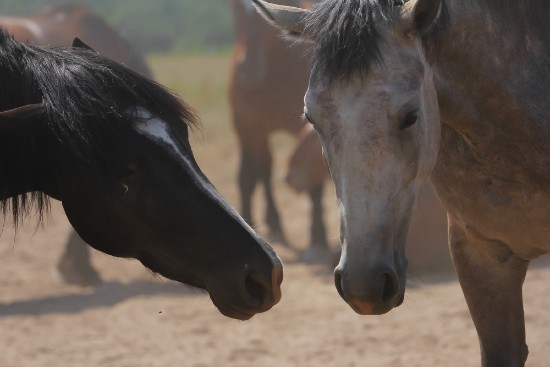
Head and Neck Communication
Horses also use their head and neck to give non-verbal cues. The most common head and neck positions include:
- Thrusting the head forward- the horse is being aggressive to another horse, or a reaction to sustained pressure on their head. A warning before a charge or attack.
- Bowing the neck- the horse is responding to aggression from another horse
- Drooping neck- the horse is asleep or resting
- Raised head and neck- the horse is active, attentive, and alert
- Head and neck are drawn back- the horse is trying to get away from something
The head and neck are key emotional indicators in both humans and horses. Paying attention to their positioning gives insight into inner feelings.
Tail Communication
Horses use their tail to communicate like dogs do. They also use it to swat away flies and protect their coats.
When the tail is swaying gently from side to side, the horse is relaxed. When a horse swishes their tail quickly or dramatically, they are stressed or annoyed. They may react aggressively.
A raised tail means excitement or happiness. Horses will keep their tail between their legs if they are afraid.

Mouth Communication
Horses use something called the flehmen response to get information about their environment. They curl their top lip back and inhale through their nose while reaching their neck out.
The flehmen response exposes Jacobson’s organ, which picks up the pheromones of other horses.
When a horse licks their lips and chews, they are content or know they have done something positive.
When a horse pulls back their lips and bares their teeth and gums, they are sending a threat to someone or something that is causing them anger.
Entire Body Communication
Sometimes, looking at the whole body rather than just one part indicates how the horse is feeling. If a horse is shaking, they are nervous or afraid.
Horses will often back themselves away from anything they are scared or unsure of. If a horse comes toward a person and reaches their muzzle out, they are curious about them.
A horse that is irritated or bothered by something may stomp one or multiple of its hooves. The irritant can be flies or something else
If a horse is tense and worried, it will move in a stiff and agitated way. When a horse is relaxed and happy, it will move in a free, graceful, flowy, way.
Combining all of the verbal and nonverbal cues, horse owners can get a wealth of information about their horses at any given time. Interpreting your horse’s behavior will help you bond with them and understand them better.
The more time you spend with horses, the better you will understand their language and its meaning.
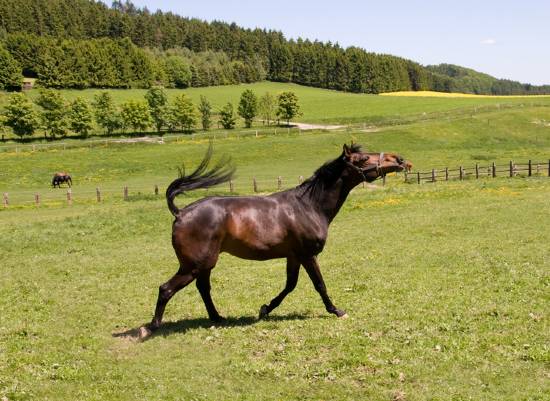
How Horses in a Herd Behave and Communicate
Herds or groups of horses also exhibit their behavior and communication. This is true of both wild and domesticated herds.
Herds of horses have one lead stallion and one or two of the mares in a herd are the lead mares. The stallion protects the herd while the mares lead the group to food, water, and shelter and defend it when necessary.
The Herd Hierarchy
In the herd hierarchy, there are dominant, submissive, and middle-ground horses. The more dominant the horse, the more powerful and bossy they are, and vice versa.
Foals are at the lowest place in the hierarchy because they are still learning and need to be protected by others. A hierarchy is always subject to change as horses get older or become ill.
All of the herd members will help look after the foals that are born.
When stallions in a herd come of age, they fight with each other to become the lead stallion or with the current lead stallion to take their place.
If a bachelor stallion loses the fight, they are often exiled from their current herd and must find another to take over.
Some bachelor stallions build a new herd from scratch by courting mares and convincing them to stay with them. You can read more about why horses are sometimes kicked out of herds here.
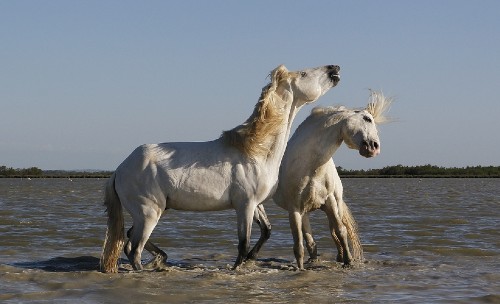
How Horses Communicate in Herds
Horses in a herd use the same verbal and nonverbal cues to communicate with their herd mates. A horse or foal that gets separated will use a whinny to find out where its family members are, for example.
Horses are prey animals. In the wild, they never lie down unless they think it is safe enough to do so or they are far enough away from predators. If your domestic horse can lie down comfortably, it means they feel safe with you. They usually sleep standing so that they can escape predators.
Herd members will also touch muzzles to greet and snuggle with each other. Herds also engage in mutual grooming, stretching their withers and backs for each other.
Play fighting among colts is normal behavior, but it can also turn into an attempt for dominance. Intervene if you notice their behavior is getting extreme.
Horses are social animals and need interaction for their mental and physical health. They are much happier in a herd or with devoted people than alone.
How Horses Communicate With Humans
The key way that horses communicate with humans is by interpreting their facial expressions. Horses can read and react to human facial expressions.
This is one of the main reasons why they are used as therapy animals. Horses also use their vocalizations with humans, because they view their owner as part of the herd.
- If horses nicker at their owner when they are bringing feed, it means they are excited about mealtime. Horses nudge or butt you with their head to get your attention or because they are getting impatient.
- A horse that is familiar and comfortable with you will stare at you when they see you from far away because they are trying to connect with you from a distance.
- Horses will usually let humans know when they do not like something through biting, kicking, and other means, although most have such a desire to please that they do not show signs of pain until it is too painful.
- In the stall or out in the pasture, a horse will turn their backside to you if they do not want to engage with you or be disturbed
- Horses will show humans they are sad by standing in a withdrawn way and showing little to no interest in things that normally make them excited.
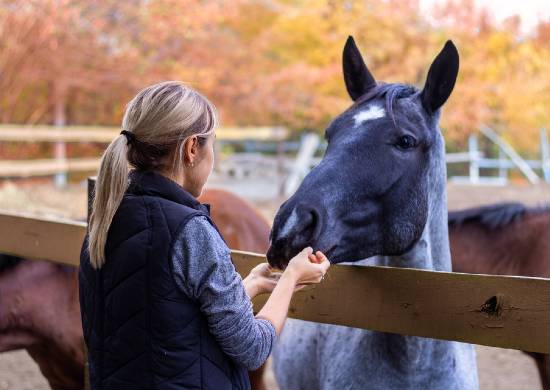
How Horses Communicate When Being Ridden
A major part of horse-human communication and vice-versa takes place under saddle. Horses are taught by their riders to respond to pressure and the aids to perform tasks.
Conversely, the rider learns what works and what does not while riding by listening to the horse’s response to what they are asking.
The more a rider understands the needs and signals of their horse, the more fluid their connection will be and the better they will work together both in the saddle and on the ground.
Understanding your horse’s signals will help you avoid unwanted behaviors like rearing or bucking. These actions are usually last-resort responses when a horse is frustrated or needs to defend itself from a harsh rider.
FAQ’s About Horse Communication
1) What are the 5 verbal signals of the horse?
The 5 verbal signals of the horse are whinny, nicker, squeal, grunt, and snort.
2) What do horses talk about?
Horses alert each other to danger, call to their herd to find them, and exchange playful and loving vocalizations and gestures with each other.
3) How do horses connect with humans?
Horses connect with humans using their body language and ability to read and interpret human emotions.
4) How do you say hello to a horse?
Hold your hand up to their muzzle in a closed fist with the knuckles facing up, and gently turn to the side.
5) Why do horses rub their head on humans?
They are trying to engage in the natural grooming behavior they do with other horses.
6) Why do horses flick their heads up and down?
This is a sign of pain, discomfort, or that they have excess energy to get out.
7) What are the signs of a horse’s trust?
They will willingly try new things with you, follow you anywhere, and stand still to allow you to halter them when you bring them in from pasture.
Final Thoughts
Horses communicate through verbal vocalizations and nonverbal body language using every part of their body. Whether with other horses or humans, horses communicate to share information with others. Communication is necessary for survival and connection regardless of species.

